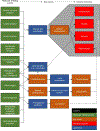Ecotoxico-lipidomics: An emerging concept to understand chemical-metabolic relationships in comparative fish models
- PMID: 32956922
- PMCID: PMC7669741
- DOI: 10.1016/j.cbd.2020.100742
Ecotoxico-lipidomics: An emerging concept to understand chemical-metabolic relationships in comparative fish models
Abstract
Lipids play an essential role in development, homeostatic functions, immune signaling, reproduction, and growth. Although it is evident that changes in lipid biosynthesis and metabolism can affect organismal physiology, few studies have determined how environmental stressors affect lipid pathways, let alone alter global lipid profiles in fish. This is a significant research gap, as a number of environmental contaminants interact with lipid signaling and metabolic pathways. In this review, we highlight the utility of lipidomics as a tool in environmental toxicology, discussing the current state of knowledge regarding chemical-lipidomic perturbations. As with most oviparous animals, the processing and storage of lipids during oocyte development is also particularly important for embryogenesis in fish. Using largemouth bass (Micropterus salmoides) as an example, transcriptomics data suggest that various chemicals alter lipid metabolism and regulation, highlighting the need for more sophisticated investigations into how toxicants impact lipid responses. We also point out the challenges ahead; these include a lack of understanding about lipid processing and signaling in fish, tissue and species-specific lipid composition, and extraneous factors (e.g., nutrition, temperature) that confound interpretation. For example, toxicant exposure can lead to oxidative stress and lipid peroxidation, resulting in complex lipid byproducts that are challenging to measure. With the emergence of lipidomics in systems toxicology, multi-omics approaches are expected to more clearly define effects on physiology, creating stronger linkages between multiple molecular entities (gene-protein-lipid/metabolite). The development and implementation of novel technologies such as ion mobility-mass spectrometry and ozone-induced dissociation support the complete structural elucidation of lipid molecules. This has implications in the adverse outcome pathway framework, which will enhance the application of lipidomics in toxicology by linking these molecular changes to effects at higher levels of biological organization.
Keywords: Adverse outcome pathways; Fish; Lipidomics; Mass spectrometry; Reproduction; Vitellogenesis.
Copyright © 2020 Elsevier Inc. All rights reserved.
Conflict of interest statement
Declaration of competing interests
The authors declare that they have no known competing financial interests or personal relationships that could have appeared to influence the work reported in this paper.
Figures
References
-
- Al-Salhi R, Abdul-Sada A, Lange A, Tyler CR, Hill EM, 2012. The xenometabolome and novel contaminant markers in fish exposed to a wastewater treatment works effluent. Environ. Sci. Technol. 46, 9080–9088. - PubMed
-
- Ankley GT, Bennett RS, Erickson RJ, Hoff DJ, Hornung MW, Johnson RD, Mount DR, Nichols JW, Russom CL, Schmieder PK, Serrrano JA, Tietge JE, Villeneuve DL, 2010. Adverse outcome pathways: A conceptual framework to support ecotoxicology research and risk assessment. Environ. Toxicol. Chem. 29, 730–741. - PubMed
-
- Arukwe A, Mortensen AS, 2011. Lipid peroxidation and oxidative stress responses of salmon fed a diet containing perfluorooctane sulfonic-or perfluorooctane carboxylic acids. Comp. Biochem. Phys. C 154, 288–295. - PubMed
-
- Ashton HJ, Farkvam DO, March BE, 1993. Fatty Acid Composition of Lipids in the Eggs and Alevins from Wild and Cultured Chinook Salmon (Oncorhynchus tshawytscha). Can. J. Fish Aquat. Sci. 50, 648–655.
-
- Balazy M, 2004. Eicosanomics: targeted lipidomics of eicosanoids in biological systems. Prostag. Oth. Lipid M. 73, 173–180. - PubMed
Publication types
MeSH terms
Substances
Grants and funding
LinkOut - more resources
Full Text Sources
Research Materials
Miscellaneous



